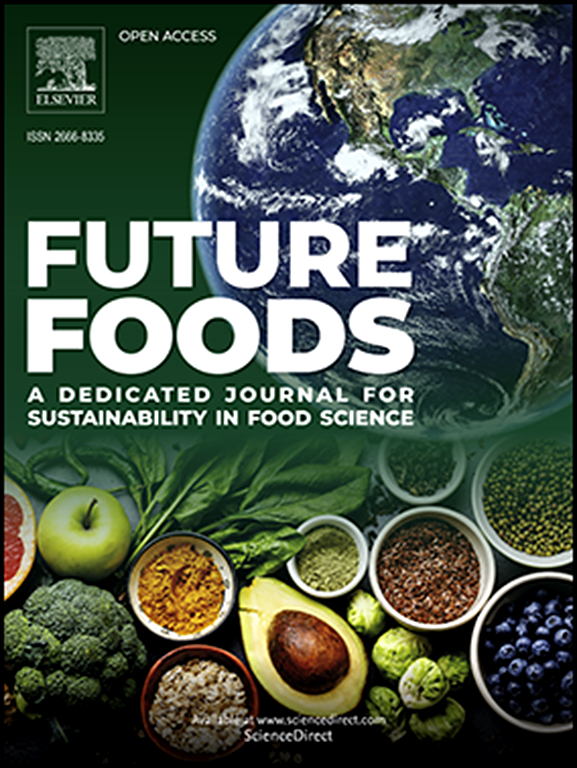Comparative study of packaging materials developed from fish and legume protein concentrates
IF 7.2
Q1 FOOD SCIENCE & TECHNOLOGY
引用次数: 0
Abstract
The environmental impact of food packaging, transportation and disposal are escalating, contributing significantly to global solid waste. There's an increasing focus by industry and research on seeking new sustainable solutions for waste valorization. This study investigates the isolation process of biopolymers from legumes (lentil) products and fish (gilthead seabream) waste, with the aim of producing composite films. The developed films were characterized for optical, mechanical and water barrier properties, hydrophobicity (via contact angle measurement), moisture content, water solubility, and biodegradability. Results indicated that lentil and fish protein concentrates may be effectively utilized to fabricate biodegradable packaging materials with adequate moisture barrier properties and excellent optical characteristics. The composite materials from lentil proteins and pectin had higher elongation at break compared to the respective value of the films produced using fish protein and gelatin (44.94 ± 2.81 % and 10.52 ± 1.21 %, respectively). Regarding the composite animal based film, the WVTR and WVP values were measured at 119.50 ± 2.90 g × s−1 × m−2 and 5.04±0.06 × 10−8 × g × m−1 × s-1×Pa−1, respectively. The composite plant based materials had higher WVTR and WVP (139.17 ± 8.01 g × s−1 × m−2 and 7.80 ± 0.91 × 10−8 × g × m−1 × s-1×Pa−1, respectively). The composite film of pectin and concentrated lentil protein exhibited hydrophobic behavior (contact angle 98.63 ± 3.78°), whereas for gelatin and concentrated fish protein films, the contact angle was determined as 57.37 ± 4.00°, indicating hydrophilic behavior. All produced films biodegraded in <20 days during burial test in soil with high relative humidity (80 %). The results of the study show the utilization of food industry potential waste for producing environmentally friendly packaging materials.
鱼与豆科浓缩蛋白包装材料的比较研究
食品包装、运输和处置对环境的影响正在加剧,对全球固体废物产生了重大影响。工业和研究越来越关注寻求新的可持续的废物增值解决方案。本研究研究了从豆类(扁豆)产品和鱼类(gilthead seabream)废物中分离生物聚合物的过程,目的是生产复合膜。对所制备的薄膜进行了光学、机械和水阻隔性能、疏水性(通过接触角测量)、含水量、水溶性和生物降解性的表征。结果表明,利用扁豆和鱼蛋白浓缩物可有效制备具有良好防潮性能和光学特性的生物降解包装材料。扁豆蛋白和果胶复合材料的断裂伸长率高于鱼蛋白和明胶复合材料(分别为44.94±2.81%和10.52±1.21%)。动物基复合膜的WVTR和WVP分别为119.50±2.90 g × s−1 × m−2和5.04±0.06 × 10−8 × g × m−1 × s-1×Pa−1。复合植物基材料具有较高的WVTR和WVP(分别为139.17±8.01 g × s−1 × m−2和7.80±0.91 × 10−8 × g × m−1 × s-1×Pa−1)。果胶与浓缩扁豆蛋白的复合膜具有疏水性(接触角为98.63±3.78°),而明胶与浓缩鱼蛋白的复合膜具有亲水性(接触角为57.37±4.00°)。在高相对湿度(80%)的土壤中进行掩埋试验,所有生产的薄膜在20天内生物降解。研究结果表明,利用食品工业的潜在废物生产环保包装材料。
本文章由计算机程序翻译,如有差异,请以英文原文为准。
求助全文
约1分钟内获得全文
求助全文
来源期刊

Future Foods
Agricultural and Biological Sciences-Food Science
CiteScore
8.60
自引率
0.00%
发文量
97
审稿时长
15 weeks
期刊介绍:
Future Foods is a specialized journal that is dedicated to tackling the challenges posed by climate change and the need for sustainability in the realm of food production. The journal recognizes the imperative to transform current food manufacturing and consumption practices to meet the dietary needs of a burgeoning global population while simultaneously curbing environmental degradation.
The mission of Future Foods is to disseminate research that aligns with the goal of fostering the development of innovative technologies and alternative food sources to establish more sustainable food systems. The journal is committed to publishing high-quality, peer-reviewed articles that contribute to the advancement of sustainable food practices.
Abstracting and indexing:
Scopus
Directory of Open Access Journals (DOAJ)
Emerging Sources Citation Index (ESCI)
SCImago Journal Rank (SJR)
SNIP
 求助内容:
求助内容: 应助结果提醒方式:
应助结果提醒方式:


